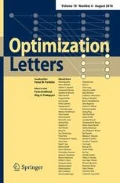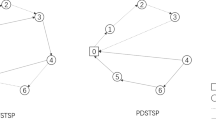Abstract
In this paper, we introduce the vehicle routing problem with drones (VRPD). A fleet of trucks equipped with drones delivers packages to customers. Drones can be dispatched from and picked up by the trucks at the depot or any of the customer locations. The objective is to minimize the maximum duration of the routes (i.e., the completion time). The VRPD is motivated by a number of highly influential companies such as Amazon, DHL, and Federal Express, actively involved in exploring the potential use of commercial drones for package delivery. After stating our simplifying assumptions, we pose a number of questions in order to study the maximum savings that can be obtained from using drones; we then derive a number of worst-case results. The worst-case results depend on the number of drones per truck and the speed of the drones relative to the speed of the truck.









Similar content being viewed by others
References
Agatz, N., Bouman, P., Schmidt, M: Optimization approaches for the truck and drone delivery problem. Presented at the INFORMS TSL Workshop, Berlin, July 8 (2015)
BBC News: Amazon testing drones for deliveries, December 2 (2013). http://www.bbc.com/news/technology-25180906
Bermingham, F.: Fedex researching drone delivery but not for widespread use, October 21 (2014). http://www.ibtimes.co.uk/fedex-researching-drone-delivery-not-widespread-use-1471063
DHL Press Release: DHL parcelcopter launches initial operations for research purposes, September 24 (2014). http://www.dhl.com/en/press/releases/releases_2014/group/dhl_parcelcopter_launches_initial_operations_for_research_purposes.html
Gambella, C., Lodi, A., Vigo, D.: Exact methods for solving the carrier-vehicle traveling salesman problem (CVTSP). Presented at VeRoLog Meeting, Vienna, June 8 (2015)
Golden, B., Raghavan, S., Wasil, E.: The Vehicle Routing Problem: Latest Advances and New Challenges. Operations research/Computer science interfaces series. Springer, New York (2008)
Murray, C.C., Chu, A.G.: The flying sidekick traveling salesman problem: optimization of drone-assisted parcel delivery. Transp. Res. Part C Emerg. Technol. 54, 86–109 (2015)
Popper, B.: Drones could make Amazon’s dream of free delivery profitable, June 3 (2015). http://www.theverge.com/2015/6/3/8719659/amazon-prime-air-drone-delivery-profit-free-shipping-small-items
Rose, C.: Amazon’s Jeff Bezos looks to the future, December 1 (2013). http://www.cbsnews.com/news/amazons-jeff-bezos-looks-to-the-future/
Toth, P., Vigo, D.: Vehicle Routing: Problems, Methods, and Applications. Society for Industrial and Applied Mathematics (SIAM), Philadelphia (2014)
Author information
Authors and Affiliations
Corresponding author
Appendix
Appendix
1.1 Proof of Theorem 3
We use the truck with speed v to traverse the giant route R formed by joining the m routes in the optimal VRP* solution, one after another. The length of route R is denoted by \(L_R\). There is no waiting time in a VRP* solution. Denote the travel time of the \(i{\text {th}}\) truck in the optimal VRP* solution by \(T_i\). We have
Again (36) is valid because a weighted average never exceeds the maximum. After we skip the depots in the middle of R, we have a feasible TSP solution such that \(L_R \ge vZ(\text {TSP}_v)\). Therefore,
i.e.,
To show the tightness of the bound, we construct an example of m customers, \(c_1\) to \(c_m\) (an example with \(m=3\) is shown in Fig. 10). The distance from \(c_i\) to the depot is \(v_i\). The distance between \(c_i\) and \(c_j\), \(i \ne j\), is \(v_i+v_j\). An optimal TSP solution has objective function value \(Z(\text {TSP})=2(v_1+v_2+\cdots +v_m)/v=2V/v\). A feasible VRP* solution serves customer \(c_i\) on a dedicated route by the truck with speed \(v_i\). All trucks finish their routes with the same travel time 2. The objective function value is \(Z^f(\text {VRP*})=2\). Therefore, in this example,
\(\square \)
1.2 Proof of Lemma 1
The ant’s journey can be divided into legs, denoted by \(\lbrace \text {LG}_{A_i,B_i}^{(i)}\rbrace _{i=1}^N\), where N, the number of legs, is not known initially. Each leg LG\(_{A_i,B_i}^{(i)}\) starts at node \(A_i\) and ends at node \(B_i\), so \(A_i=B_{i-1}\), for \(i=2,3,\ldots ,N\), and both \(A_1\) and \(B_N\) are the depot. We determine the rest of the \(A_i\)’s and \(B_i\)’s and the vehicle used by the ant using a recursive algorithm, starting backwards from the last leg LG\(_{A_N,B_N}^{(N)}\) to the first leg LG\(_{A_1,B_1}^{(1)}\). For the \(i\text {th}\) leg, we first determine the vehicle used, then \(A_i\), which is also \(B_{i-1}\).
On the last leg, the ant has to stay on the vehicle that returns to the depot last. Ties are broken arbitrarily, but if a drone is on the truck when it reaches the depot, it is not considered. If the last vehicle used by the ant is the truck, \(A_N\) is the first pick-up node of some drone when one traces the truck route in reverse order. If the last vehicle used is a drone, then \(A_N\) is the node where this drone was dispatched. Therefore, \(A_N\), hence \(B_{N-1}\), is always a pick-up node or a dispatch node.
For the other legs, the vehicle used is determined by its end point, \(B_i\). If it is a pick-up node, the ant should stay on the vehicle that arrives at \(B_i\) last. If \(B_i\) is a dispatch node, the ant stays on the truck. After we determine the vehicle, we locate \(A_i\). If the ant stays on the truck, then \(A_i\) is the first pick-up node when one traces the truck route in reverse order starting from \(B_i\). If the ant stays on a drone, \(A_i\) is the node where that drone is dispatched.
The algorithm continues until we reach the depot again. \(\square \)
Rights and permissions
About this article
Cite this article
Wang, X., Poikonen, S. & Golden, B. The vehicle routing problem with drones: several worst-case results. Optim Lett 11, 679–697 (2017). https://doi.org/10.1007/s11590-016-1035-3
Received:
Accepted:
Published:
Issue Date:
DOI: https://doi.org/10.1007/s11590-016-1035-3





